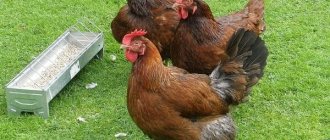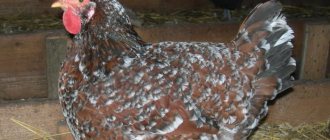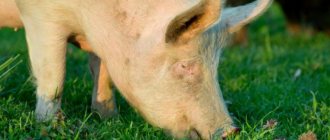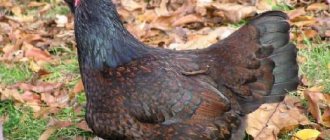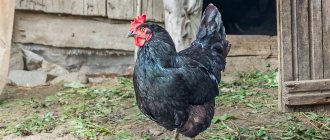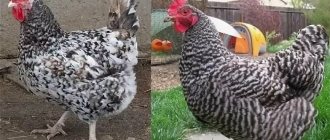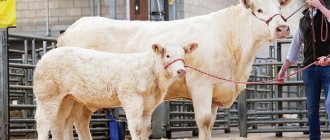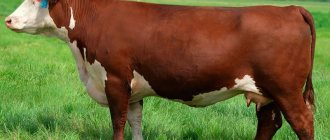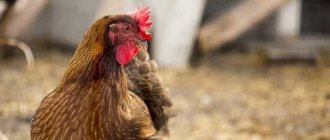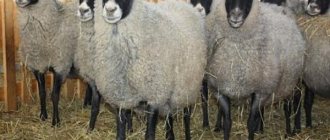Modern poultry farming is replete with a variety of chicken breeds that shine with productivity indicators. During the cultivation and breeding of breeds, their endurance and ability to adapt to different climatic conditions are important.
One of the best in this sense is considered to be the Faverolles chicken breed, which came to us from France. Thanks to the combination of consumer qualities and decorativeness, these pestles are gaining more and more popularity.
The peculiarities of growing and breeding fireball chickens will be discussed further.
Description of the breed
Photo:
The faverole chicken has the following external characteristics:
- Head: small, flat, slightly flattened.
- Beak: short, powerful, white, light yellow or pinkish.
- Comb: simple, medium-sized, erect, low, leaf-shaped, with high, evenly cut teeth.
- Neck: dense, moderately long, with a lush mane extending to the back. The neck collar is characteristic, on which some feathers are directed horizontally, others upward, towards the back of the head.
- Eyes: orange-red, medium.
- Face: red, pubescent. The lobes are feathered with sideburns, and under the beak there is a beard. Earrings are underdeveloped.
- Body: slightly elongated, trapezoidal, with a massive chest and developed muscles. The back is long, turning into a strong loin with rich plumage.
- Belly: deep.
- Tail: raised, with short tail feathers, in chickens - roof-shaped. Roosters have short, curved braids on their tails.
- Wings: located high on the body, tightly fitted.
- Legs: with lushly feathered short tibiae, but without a “hawk” tuft, well developed. A distinctive feature of the breed is the fifth toe, which is located above the hind toe, with a clearly separated long claw pointing upward. The fourth finger is placed horizontally.
- Plumage: lush, soft, loose. Abundant plumage helps firewoods survive frosts normally in winter. Small feather “pillows” are noticeable.
- Bones: thin.
- Skin: creamy white.
- Color: varied. Silver and salmon colors are considered standard for the breed.
Note! Faverole chicks are very beautiful; they are born with yellow or yellowish-yellow down. At the age of 14 days, their gender can be determined by the color of the tips of their feathers: in cockerels the tips of their wings are dark, in hens they are almost white. At the age of 8 weeks, males develop a beard and sideburns.
Fireballs have a trusting, open character. They quickly become tamed and recognize their owner. Calm, they remain in one place for a long time, contemplating the surrounding space. Balanced, easy-going with their walking neighbors.
The second reason is character and behavior
The character of faverolles is “golden”: the chickens are calm, sometimes phlegmatic, quickly tamed, and get along well with other poultry . Males rarely engage in cockfighting. When the owner appears, the birds rush to meet him in the hope of getting something tasty, but they are always sincerely happy to communicate even without delicacies. They love to be petted. They are distinguished by their “talkativeness.” They get along great with children. These birds are gentle and patient, playful and trusting. They graze with pleasure (like geese) and, unlike other chickens, practically do not rake the ground with their paws.
Chickens instantly become attached to their owner, responding to his love with complete reciprocity
Keeping chickens of this breed is quite simple. They are poor fliers, so they do not require high barriers . The perches in the poultry house should be low and equipped with a ladder so that the chickens can climb up it. Birds thrive in confined spaces, but if space permits, it is best to give them more freedom. Additional activity will not allow laying hens to gain weight (the main disadvantage of the breed is the tendency to gain excess weight and obesity with a sedentary lifestyle and excellent appetite).
Pullets on pasture. Before releasing the bird, you should check the area for the presence of poisonous plants (henbane, black nightshade, etc.)
Rejection criteria
Since the Faverol breed is an exhibition breed, there are strict culling criteria.
Reasons for rejection may include such shortcomings as:
- too narrow or shortened torso;
- curved horizontal back;
- thin neck of chickens without a characteristic “hairstyle”;
- beak yellow or blue;
- weak expression or absence of the fifth finger;
- large and tall scallop;
- tail too long; the metatarsals have lush plumage; the beard and sideburns of males are sparsely feathered; there is a “hawk heel”.
Breed standards:
- correct comb shape;
- short tail;
- lush sideburns and beard;
- the presence of a “hairstyle” in females;
- developed fifth finger with a vertically directed claw.
Signs of poor breeding
It is very important to monitor the purity of the Faverol breed. The offspring obtained from mixing with other breeds of chickens will be less hardy than the previous generation, and in the future may lose their characteristics.
The main sign of poor breeding of a Faverol hen or rooster is underdeveloped muscles. A very squat or, conversely, very tall body, a thin or insufficiently long neck, an uneven back (for example, too arched), a long sharp tail - all this leads to the culling of birds from the pedigree herd.
It is also worth paying attention to the paws: birds without a fifth toe, with a “hawk’s heel”, or with an incorrect position of the fourth and fifth toes will not be able to pass standardization.
The absence or insufficient size of a chicken's hairstyle, and slight plumpness of plumage on the neck and sides of roosters are also a sign of poor breeding. A yellow beak, a disproportionate crest, and an excessive number of feathers on the metatarsals indicate a mixed breed.
Origin story
The roots of the Faverolles chicken stretch from France: the breed is named after the town of Faverolles. The local peasants, who specialized in breeding poultry, created several meat varieties of chickens.
In the second half of the 19th century, the breed gained popularity among European poultry farmers. At first, chicken was valued only as meat, but English breeders improved the breed, giving it interesting plumage. As a result, it became a show breed and at the same time a meat breed.
In Germany, a club of firefly lovers was even created, whose members began to make attempts to enhance the egg production of this breed. As a result, the salmon-colored “Lachshuner” fireball was bred, capable of laying eggs even in the cold season.
History of breeding the Faverol breed
France is the birthplace of the Faverolles breed. The bird received its name from the place where it was created as a result of mixing the Manta and Gudan breeds. Later, chickens of the Silver Dorking and Cochin breeds were involved in breeding work.
From first-class broth meat, Faverol has turned into a gourmet meat breed. The variety has taken root well in Russia.
Faverolles
Productivity indicators
Faverolles are mostly meat chickens, they should be large and heavy, quickly build muscle mass. The quality of the meat is above average. Tender and white, it is valued for its juiciness and fine fiber. The taste of the meat is similar to pheasant.
The live weight of an adult female reaches 3.5 kg, roosters are able to gain weight up to 5 kg. The feathers are easy to pluck, the bones are thin and light.
Faverole chickens have an average level of egg production. They are capable of producing about 160-170 eggs in the first year. The weight of one egg ranges from 55 to 60 g.
The color of the egg is brown, with a pinkish or yellow tint. The shell is dense. In subsequent years, the level of egg production decreases to 130 eggs per year. Chickens begin to actively lay eggs at 6 months. Eggs can be stored well at +10°C for 2 weeks.
The weight of cockerels ready for slaughter is from 3.1 to 4 kg, and that of chickens is from 2.5 to 3.2 kg.
Breed characteristics
Representatives of the Faverolles chicken breed, like true French women, have a very attractive appearance. Faverolles hens in any herd can be distinguished by the characteristic frame on the head (whiskers) and the feathering on the legs in the form of panties.
The beak of chickens of this breed is short, but extremely strong, white or pink. Adults are distinguished by a simple and vertically oriented comb with high teeth. The color of the pupils in males and females is orange-red.
The neck of typical representatives of the breed is of medium length and covered with a kind of mane. The tail is not long and slightly raised, the tail feathers are short and covered with curved braids of short length. The chest, like the belly, of classic representatives of the breed is deep and wide, the wings are located quite high and fit snugly to the body
This is perhaps what you should pay attention to when describing the exterior of the Faverol breed chickens
But Faverolle chickens are not bred for their beauty. According to reviews, the meat of these chickens is valued by gourmets for its tenderness and very refined taste, which makes it possible to serve dishes from it in the most respectable restaurants on the planet. With thin bones and good live weight, Faverolle chickens sell very well for any kitchen.
The Faverolle chicken breed is a precocious breed, i.e., a fast-growing breed for meat production. Average egg production is approximately 180 eggs in the first year of laying and 130 eggs in the second year. The eggs of laying hens of this species have a strong yellow or brown shell; The minimum weight of one egg is 60 grams.
The weight of a rooster can reach four kilograms, and a hen up to three and a half kg. Faverol chickens are very frost-resistant, however, they are often prone to obesity. The character of chickens is calm, even somewhat phlegmatic.
Reviews
Poultry farmers characterize fireball chickens mainly on the positive side, emphasizing the following advantages of the breed:
- rapid growth of young animals;
- adaptability to cold climates;
- high productivity;
- good egg production, including in winter;
- excellent taste of meat.
In their reviews, farmers point out only 2 disadvantages of the fireball breed:
- tendency to obesity (the weight of chickens must be constantly monitored);
- inability to maintain their productive properties when crossed with individuals of other breeds.
In conclusion, we note that the above disadvantages of the fireball breed disappear with constant and competent care of the bird.
Character of chickens
We recommend reading our other articles
- Tomato Polbig F1
- What can and cannot be given to turkeys
- Tomato Pink Giant
- Why do orchid leaves turn yellow?
Chickens of this breed have a calm disposition. They get along with other breeds without problems, quickly get used to the owner (in 2-3 days), and are very trusting. Birds are curious, inquisitive and observant. They can simply stand still and look at what interests them for a long time or run around the area squealing for goodies.
The rooster is strong, but not aggressive, does not start fights and usually does not even defend territory. This is both a good and bad trait, because more cocky roosters of other breeds can literally peck at him. So you need to carefully monitor this and do not put roosters of this species in the same coop with fighting males.
The rooster is strong, but not aggressive
Important!
Faverol chickens are not found in poultry farms and poultry farms in Russia, so you can only purchase high-quality, purebred individuals abroad. The birds sold on the market under this name are most often just crossbreeds.
Varieties
There are 3 types of fireball chicken breeds:
- salmon (Lachshuner);
- Colombian (silver);
- blue.
Salmon faverolle
The hens and roosters of this variety are slightly different.
Description of females: feathers are pink-red with a white edge; a lighter shade is noticeable on the belly and chest. The pen shaft is white. The tail and neck are dark brown, with a reddish tint. Breasts, legs, belly - milky.
Description of roosters: chest, tail, belly, beard, sideburns, legs and metatarsals - black, brown-red, with yellow and white splashes. The feathers on the back are ivory. On the neck collar and flight feathers there is a black-green or brown-copper stripe with a mirror shine.
Important! To maintain the purity of the salmon variety, only roosters that have brown spots on the neck are suitable.
Colombian (silver) faverolle
This variety has a main color of silver-white, both in chickens and roosters. On the mane and tail there are blue-black stripes with a green tint.
The outline of the feather is clearly outlined by a white border. The flight feathers on the wings are black with white edging; when the wings are folded, the black color is not noticeable. The down and feathers of the second row are white, without inclusions.
Blue fireball
The main color of the plumage is blue of varying intensity with a clearly defined outline of the feather.
Chickens
Breeding a breed is quite a troublesome business. It is very important to store hatching eggs correctly, then there is a chance to get the maximum number of offspring from them. According to statistics, chickens hatch from 75% of eggs laid for incubation. Babies also do not tolerate hypothermia, especially during the first days of life.
Babies are born with light fluff on their paws, and it is also noticeable how sideburns and a beard appear, but in French babies this is not as pronounced as in their genetic ancestors - Cochins. Salmon crumbs are covered with light brown fluff, while Colombians are yellow with mottled wings.
Feeding occurs in chicks quite quickly - in 3-4 months they are completely covered with “adult” coats. Babies of this breed are characterized by rapid growth and muscle gain typical of the meat-egg type, which is why they need increased nutrition.
Breeding
The optimal time for hatching chickens is February. In the spring, the chicks can be released for walking, and in the summer, the young hens will begin to lay eggs.
Important! In order to avoid inbreeding, which leads to defects in chickens, degeneration of the breed, and decreased productivity, it is necessary to keep at least 5 hens and one rooster of a different line.
At the same time, you should not keep more than 15 heads.
To hatch chicks, eggs are taken from chickens that have reached one year of age. They are stored at temperatures up to +10°C for no more than 2 weeks.
Since fireballs are not the best hens, it is better to hatch chickens in an incubator at a temperature of + 37.6 ° C. The slightest temperature difference leads to the appearance of inverted toes and toes in chickens.
Hatching occurs on the 22nd day. Newborns are placed on a warm, dry bedding; the room temperature is maintained at + 38°.
In cloudy weather and during short daylight hours, additional lighting is necessary.
Features of maintenance and care
It is recommended to raise Faverolle chickens using the floor method. There should be approximately 4-5 chickens per square room. Comfortable perches are made in the chicken coop at a distance of 50-60 cm from the floor, but a ladder is placed on them so that the birds can easily reach their sleeping place. They also set up nests for laying hens, a place for feeders and drinkers. It is advisable to install a basin with sand and ash for cleaning feathers.
Comfortable perches are made in the chicken coop at a distance of 50-60 cm from the floor
Dampness and drafts are unacceptable. It is necessary to ensure ventilation, good lighting and warmth in the room (preferably heating). The bedding is made of straw, sawdust or peat, in a layer of 10-15 cm. This breed requires cleanliness due to its abundant plumage and feathered legs. So cleaning is carried out every day and once a week the litter needs to be partially replaced, removing dirt.
Important!
Faverolles chickens are prone to obesity. If you do not need to fatten them for meat, then it is worth providing the bird with daily walks in the fresh air. Such physical exercises will allow them not to gain excess weight and avoid illnesses.
The bedding is made of straw, sawdust or peat, in a layer of 10-15 cm
The walk is spacious. If there is not enough space in the chicken coop or on the run, egg production will decrease - chickens of this breed are very sensitive to cramped conditions. If it is not possible to have a walk, you can simply let the chickens out into the garden for walks. These chickens usually do not dig, so the crops will not be damaged. And since this breed does not fly, chickens do not need a large fence.
Feeding adults
Adult faverolles require a balanced diet. Preference is given to dry food and mixed feed. Wet food stains the lush plumage of birds. Pecking out the remains stuck in the feathers, the chickens acquire an unkempt appearance and cause injuries to each other.
In the summer, one third of the daily feeding consists of green mass, pasture. The most suitable herbs and legumes are:
- woodlice;
- nettle;
- meadow clover;
- dandelions;
- alfalfa;
- purslane;
- oats;
- peas;
- wheat.
After walking the chickens, they are fed with mixed feed and grain. The daily norm per head is 150 g. When obesity begins, chickens should be put on a diet, reducing the daily norm to 80 g.
In winter and spring, the green mass is replaced with sprouted wheat grains, pumpkin pulp, carrots, zucchini, dried beet and carrot tops, steamed nettles, pine, spruce and fir needles.
Important! Vitamin supplements are required. When egg yield is reduced, oatmeal is added to the diet. During cold periods, wet food is heated.
With a combined diet, the fireballs are fed 3-4 times a day, alternating dry and wet mixtures.
Maturation speed and egg production
“Early birds” - these words can describe the representatives of Faverol. Their maturation proceeds quite quickly, and already at 4-4.5 months they produce their first testicle. Although experienced breeders claim that Colombians begin their working “career” a little earlier.
In addition, Colombian males gain weight much faster. At first, the result of their labors is 1-2 eggs per week, and then they pick up speed and lay once every one and a half days. In total, one hen lays about 180 eggs per year. All of them are not large - about 60 grams, and have a soft pink shell.
Conditions of detention
Faverolles must be separated from representatives of other breeds to preserve the purity of the offspring. To do this, it is enough to fence the area with a low fence. They are calm birds and do not try to fly over obstacles.
The area where they are kept must be very large so that the chickens have the opportunity to roam freely, thereby reducing their incidence of illness and the need for synthetic additives.
It is better to use hanging feeders or in the form of narrow troughs: this way they will not scatter the food and rummage through it with their paws, which is typical for chickens. Make the perches round and wide, place them low, providing special ladders to make it easier for the massive bird to climb.
It would be nice to sometimes let them out for free range, which will ensure greater egg production. It should be noted the delicacy of this poultry: when searching for insects, fireballs do not tear up beds and flower beds.
The fifth reason is gastronomic
If the first four reasons are not enough, then there is another reason to fall in love with this breed of chicken - white tender meat, which has a rich taste and fine-fiber structure. In France, restaurateurs especially value free-range faverolles: their meat is more aromatic and tastes like pheasant.
The carcass of a 4-month-old cockerel has a very appetizing appearance, has a large breast with thin and light bones
Firewood meat at the age of 6-7 months is just as tender and juicy, and cooks in the same time as that of young broilers. Another significant advantage of the breed is that there is no need to singe the carcass; feathers are plucked easily and quickly.
In France, there are still dishes that are prepared exclusively from poultry of this breed.
We offer a recipe for one of the simple traditional dishes of Faverolles - tender chicken breasts for a festive feast .
Ingredients:
- chicken breast (fillet) – 4 pcs.;
- apple (large) – 2 pcs.;
- mushrooms (champignons) – 200 g;
- Calvados (apple vodka) and sour cream - 6 tbsp each. l.;
- butter – 50-70 g;
- salt and pepper - to taste;
- greens (parsley) – 1 bunch.
Cooking algorithm:
- Salt and pepper the breasts.
- Melt the butter in a frying pan, fry the meat over high heat on both sides until half cooked (about 10 minutes), place on a plate.
- Cut the apples into slices (4-6 parts) and core them.
- Add oil to the pan and fry the apples until a crust forms. Add them to the chicken.
- Fry the mushrooms (large ones can be cut into pieces first) over high heat, stirring, for 3-5 minutes.
- Add meat and apples to the mushrooms and heat.
- Pour Calvados into the pan and set it on fire. After the flame goes out, add sour cream little by little, mixing the ingredients with the sauce. Reduce heat and simmer for another 10 minutes.
- Place on a plate and sprinkle with finely chopped parsley.
Boiled potatoes, rice or homemade noodles are perfect as a side dish for this delicacy (and don’t forget to pour dry red wine into the glasses!).
Diseases
Chickens of this breed are resistant to diseases due to genetic properties. The main danger of an outbreak of infectious diseases lies in the increased humidity of the chicken coop litter and unbalanced nutrition. If the above regime is not followed, the chicken gets sick and dies.
The most common problem for firewood, as for all chickens, is parasites, from which only competent prevention can save you.
So, the fireball is a breed of chicken that poultry farmers value for its aesthetic appearance and excellent taste of meat and eggs.
Undemanding maintenance and high productivity are the 2 main qualities that, judging by the reviews of poultry farmers, are characteristic of firewood. Among the disadvantages are a tendency to obesity, difficulties in acquiring and maintaining the purity of the breed.
The path to the international arena
Only by the middle of the 19th century did the new breed spread throughout Europe, came to America and received the official name from its place of origin - Faverol. By the end of the 19th century, the first birds of this breed appeared among Russian breeders.
By the end of the 19th century, fireball chickens began to be bred in Russia
The path of faverolles to the international arena was long. At first, they were grown only in their homeland, in France, and even then only in individual small farms. The meat was sent to local restaurants, where regulars soon noticed that the taste characteristics of dishes with meat from birds of this breed were much higher than that of the then popular industrial meat breed Plymouth Rock.
Plymouth Rock is a popular breed of meat chicken.
When Europe became interested in the new species, German scientists carried out a production selection of Faverol - Lachshuner.
By the way! German breeders, who continued their research, developed a breed of dwarf fireweed in the 20th century. They weigh no more than a kilogram, have tasty and tender meat, and are distinguished by an unprecedented egg production for miniature breeds - 120 forty-gram eggs per year.
Dwarf faverolle
The first firewood was not particularly beautiful. Their appearance was quite common, since the purpose of breeding was high-quality meat and high productivity. But then, believing in the great potential of the breed, German and English breeders decided to turn firewood into first-class show birds. In which they succeeded. Thanks to the efforts of the Germans, a bird of extraordinary beauty was obtained - Salmon Faverol (“Lachshuner” is “salmon”, translated from German). And then, with the help of English poultry farmers, Faverolle birds appeared with white, sand, black, coffee, blue and other colors.
German selection of firerolls - Lachshuner.
By the way! A distinctive feature of both females and males of the breed is lush plumage around the paws and large sideburns. They are in the poultry yard - like French barons and baronesses who dressed up in lace for a palace carnival.
The breed has its advantages and disadvantages, but there are still many more of the former, and they are more significant.
Advantages and disadvantages of the breed
Advantages | Flaws |
| high taste characteristics of meat; | females tend to be obese; |
| fast growth; | chickens are not good brood hens; on the contrary, as a result of numerous crossings, they have practically lost their brooding instinct - for breeding they will have to use an incubator; |
| high productivity; | when crossed with individuals of other breed varieties, they quickly lose their productive characteristics. |
| continuation of egg laying in winter; | |
| good tolerance to low temperatures. |
Molting and break in egg laying
Like many others, Frenchies molt every fall. The molting process is often painful - appetite and activity decrease. As a rule, this cross does not require artificial stimulation of shedding, so there is no need to interfere.
Only one thing is important - during this period, daily supplement the menu of molting beauties with vitamins, minerals, and fish oil. And also - monitor health during this difficult period, when the herd is most vulnerable.
The duration of the productive period is about 3 years. Therefore, at approximately this age, a shift should be prepared for them. If you keep quakes longer, they will no longer be able to serve as a source of meat, since their taste is lost.
Advantages and disadvantages
Chickens are resistant to harsh climatic conditions, are distinguished by their endurance and resistance to most inconveniences of keeping (with the exception, as mentioned, of high humidity). They quickly reach the production period and egg production.
With optimal production characteristics, their additional advantage is a very attractive appearance. Characteristic features are a cervical collar, five-fingered feet, a goatee, and characteristic sideburns. In addition, birds have tender and very tasty meat.
Among the disadvantages, poultry farmers observe a predisposition to obesity, as well as difficulties in purchasing and maintaining the purity of this breed.

